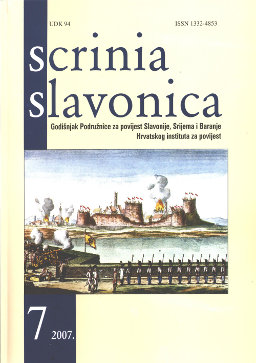PRILOG ISTRAŽIVANJU DOGAĐANJA NA GRADIŠKOM PODRUČJU TIJEKOM RATA 1788-1791.
A CONTRIBUTION ON THE EVENTS IN THE GRADIŠKA AREA DURING THE HABSBURG-OTTOMAN WAR OF 1788-1791
Author(s): Iva Salopek BogavčićSubject(s): History
Published by: Hrvatski institut za povijest
Keywords: Austrian-Ottoman War 1788-1791; “Dubica War”; border fortresses; Stara Gradiška; Bosanska Gradiška (Berbir); graphic representations
Summary/Abstract: This paper is based on an interpretation of several picture graphics and schemes of Gradiška and Berbir from 1788-1792, one Viennese newspaper from 1789, some church annals, and a few pieces of folk poetry from the 19th century. Gradiška was divided into two border settlements after 1699, each being formed as a fortress on one of the the opposite river banks, Austrian (Slavonian) and Ottoman (Bosnian). The settlement on the left bank of the Sava was called Gradiška, and the one on the right river bank was called Berbir. During certain periods, such as 1717-1739, Berbir was in Austrian hands. The systematic reconstruction of the Gradiška fortress following the Vauban method took place at that time. After 1739, reconstruction and fortification methods used in Berbir were out of date in comparison with Gradiška. That was a very important fact for the course of the Austrian-Turkish war of 1787-1791, because war preparations and starting points on each side were different. After 1767, Gradiška become a military fortress and all of its civil elements were abolished. Secret projects of mapping the Bosnian teritory, spying the enemy’s reconstruction works at Berbir, and preparing the Gradiška fortress for a future war, all took place in the last third of the century. On the border near Gradiška, first minor clashes were provoked as early as 1783, but the war started on February 9, 1788, simultaneously at several different points of the Austrian-Turkish border. The pictures (etchings) published by Thomas Trattner show Gradiška, Drežnik, Rama and Orşova (Orsowa) in 1788 as the places of the first artillery battles. A part of the etchings where Gradiška is shown also explains the directions of the artillery attacks. The second artillery battle occurred between Gradiška and Berbir on February 21, 1788, and it is shown on a second picture published by Trattner, where the damage caused by the first and the second artillery battles can be seen. A third picture shows a scene from the battle which took place on February 21, 1788, and unlike the previous two it does not include a ground plan. On the basis of the contemporary newspaper Wienerblattchen from April 1789, writings of the regiment’s archivist Luka Ilić Oriovčanin, annals of the Franciscan monastery in Cernik, and some folk poetry from the 19th century, the course of the siege of Berbir by general Laudon can be reconstructed in detail. This final battle, in which the Austrians were victorious, occured in the summer of 1789. It is also shown on a fourth and a fifth etching, published around 1790 by an author different from the previous one. These pictures appeared after the Austrain-Turkish war, their main purpose being propaganda and education, which makes their historical value questionable. After the siege and occupation of Berbir, Gradiška and Berbir became a united settlement once again, but this situation could not last for long, because the Peace at Svištov (1791) obliged the Austrians to retre
Journal: Scrinia Slavonica
- Issue Year: 2007
- Issue No: 7
- Page Range: 161-201
- Page Count: 41
- Language: Croatian

